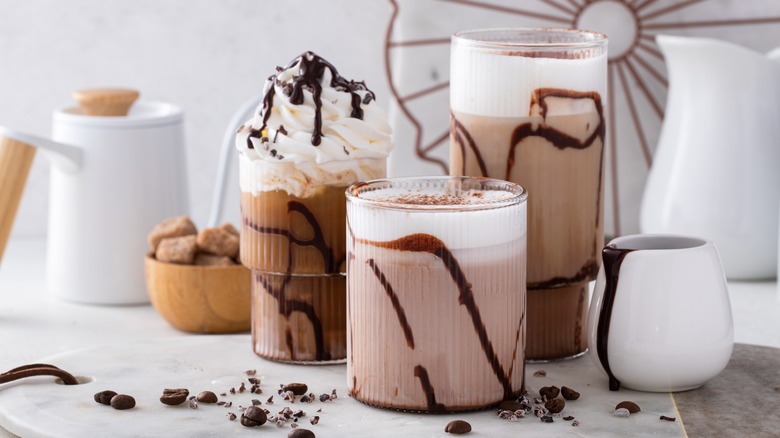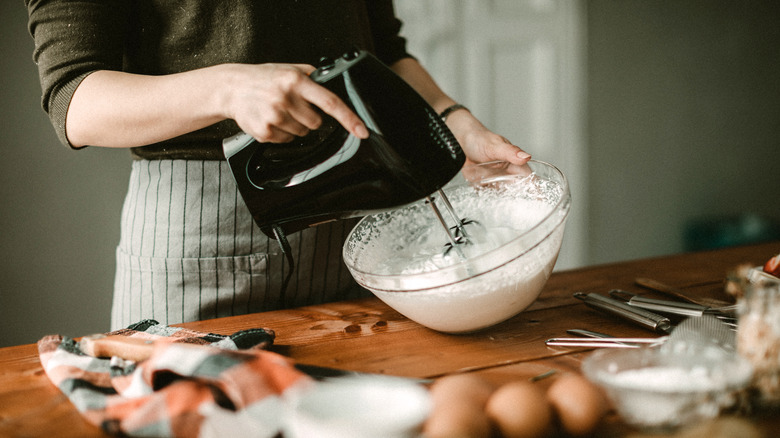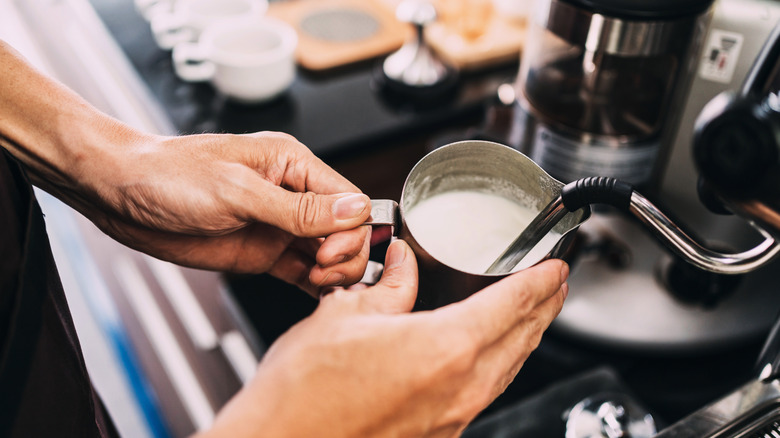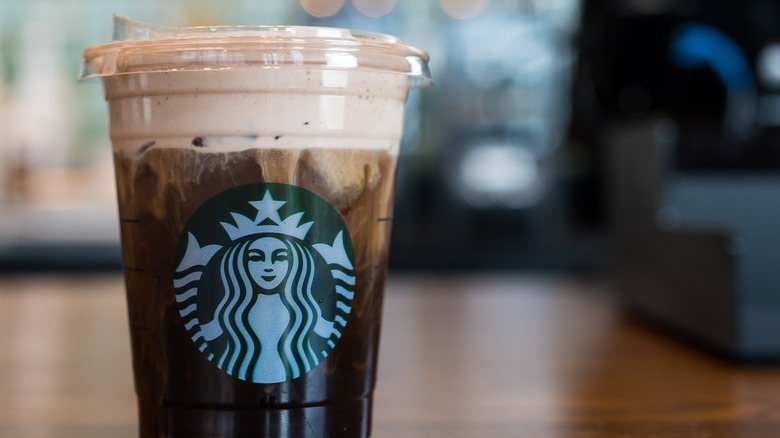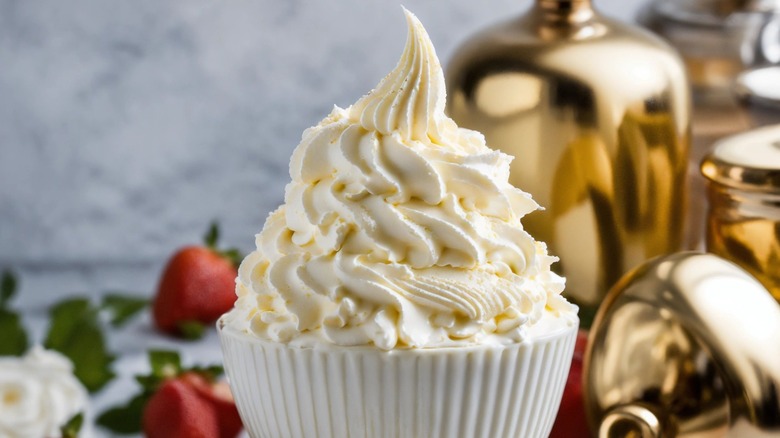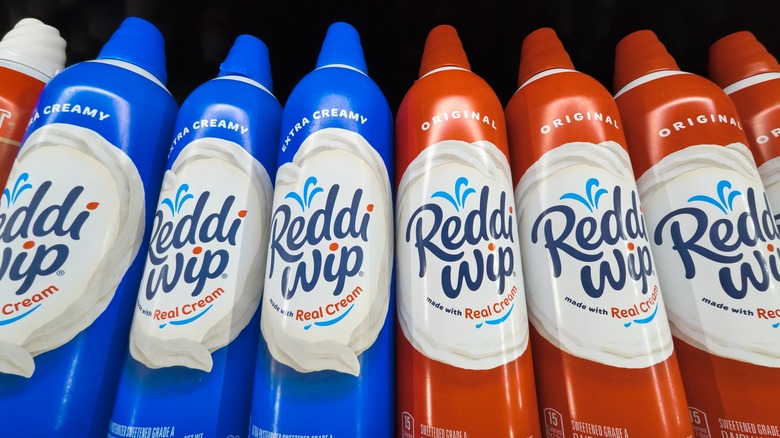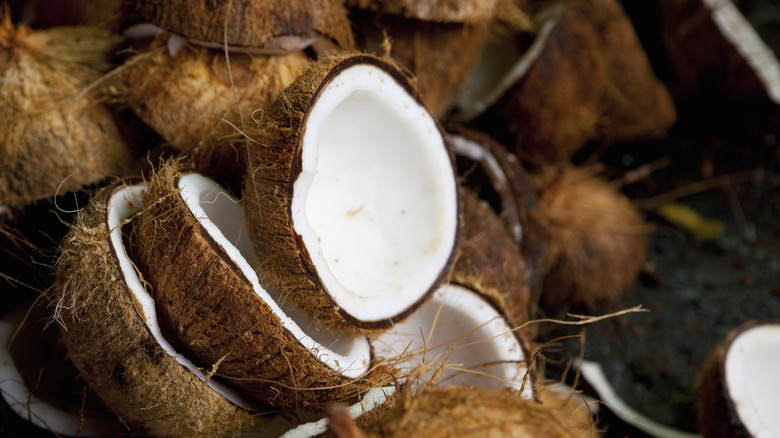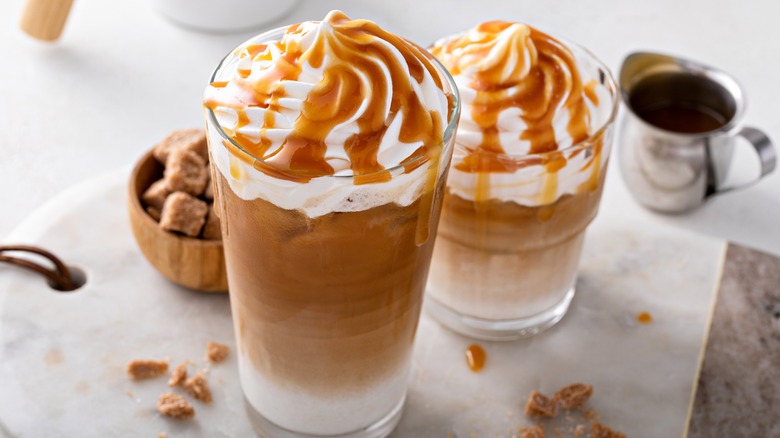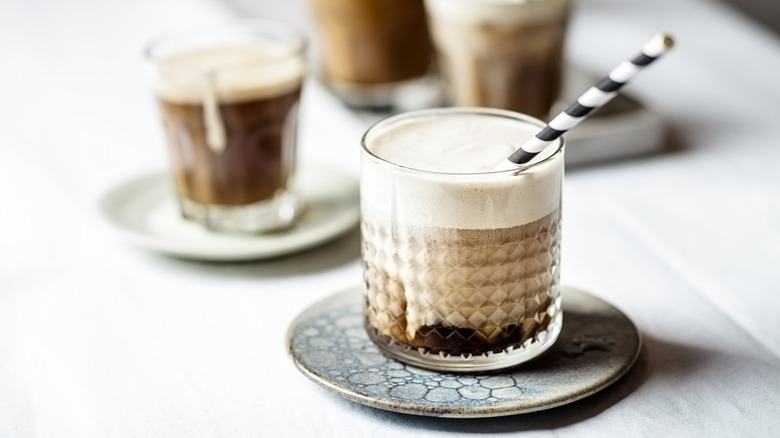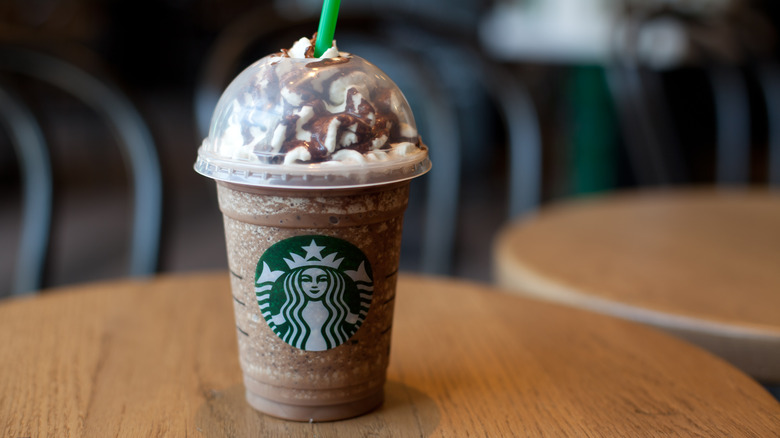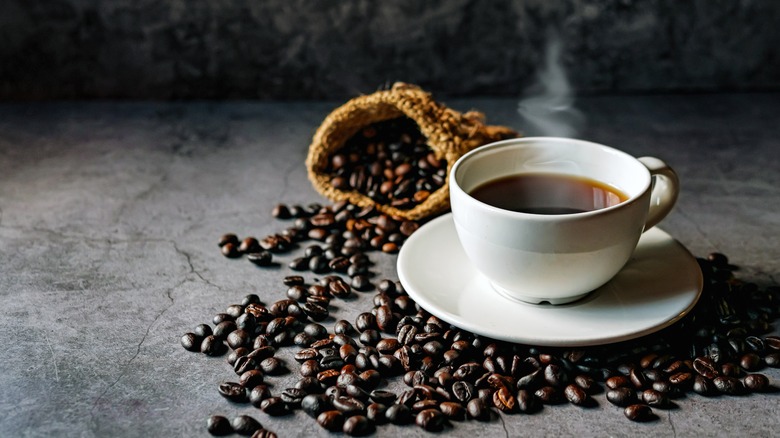What Makes Cold Foam Different From Whipped Cream?
These days, I can't quite seem to leave a coffee shop without adding cold foam to my drink. It's taken over my local Starbucks menu, my TikTok feed, and certainly my morning coffee. With the sweet topping's recent rise to fame, some insist that cold foam is something we've already seen before in shiny new packaging — in other words, rebranded whipped cream.
But spoiler alert: it isn't. I'll admit that even I had never really given the difference between the two much thought until recently. I was ordering my go-to Starbucks drink (an iced cinnamon dolce latte) with cold foam when the barista hit me with an unexpected question: "Do you still want whipped cream with that?"
I was caught off guard. Weren't cold foam and whipped cream pretty much the same thing? Apparently not, if he was asking me that question. If you've ever wondered what exactly sets the toppings apart, don't worry. Today, I'm settling the debate once and for all and diving into what makes cold foam different from whipped cream.
Whipped cream is made using cream
To the surprise of absolutely no one, whipped cream is made from (drumroll please) ... cream. It's really shocking, I know. But while many of us dollop it onto our drinks without a second thought, few understand how the sweet topping actually came to be.
If you didn't know, cream is a product of milk as it is derived from the fat-enriched portion, which naturally floats to the top. (The next time you grab a carton of fat-free milk, just know that it's likely it was once one with some of the cream products on the grocery store shelves).
Cream is transformed into the whipped consistency we all know and love by, you guessed it, whipping it. But it's not as easy as it sounds. Don't whip it long enough, and you'll be stuck with a sad bowl of cream. Whip it too long, and you're left with a batch of butter. The secret is whipping until the perfect moment when the cream forms soft peaks. Otherwise, you may have a buttery mess on your hands.
Cold foam is made using milk
I'd argue that the creation of cold foam is even more of a mystery than whipped cream. At least with whipped cream, the instructions are practically right there in the name. But cold foam? Now that's a bit less straightforward.
Rather than cream, cold foam is made from milk. It's made specifically from fat-free milk because less fat means more stability, allowing a more foam-like consistency to form. So, in a way, whipped cream and cold foam are long-lost siblings, originating from the same batch of milk but going their separate ways and being forced to compete with one another. It's kind of poetic (and a little tragic) if you think about it.
Cold foam can be made in various ways, from frothing to whipping to shaking it up in a mason jar. Unlike whipped cream, the margin for error when making cold foam appears to be larger. After all, overwhipping it won't turn it into butter.
Cold foam has only been popular in the United States for a little over 10 years
Maybe it's just me, but the cold foam hype feels like it came out of nowhere. I mean, I went from having no idea that this sweet and airy coffee topping even existed to seeing it on my For You page 24/7. While cold foam wasn't exactly born overnight, its rise in popularity (in the United States, at least) has been surprisingly fast.
Starbucks appears to be largely responsible for putting cold foam on the map. The topping became more popular in the United States when the chain introduced it back in 2014 in one of its menu items at the time, the Americano Con Crema. But the topping outlasted the drink itself. While the Americano Con Crema disappeared from the menu, cold foam was here to stay. By 2018, Starbucks added cold foam as a permanent menu item that customers could add to any drink of their choice, including some more unconventional options such as the iconic Refreshers.
Despite its sudden surge in popularity, though, cold foam is still in its early days — especially compared to whipped cream, which boasts a long history in American and global cuisine. If you walk into your local coffee shop and ask for a dollop of whipped cream, I'm sure they'd be happy to oblige. But cold foam? Now that's a bit less likely. If cold foam keeps gaining traction, though, perhaps coffee shops might have no choice but to make room for the sweet substance on regular menus.
Whipped cream has a much longer history than cold foam
While cold foam has only been popular for about a decade, whipped cream has been a fan favorite for centuries. Its origins date back to 16th-century Italy, where chefs whipped up a combination of sugar, cream, egg whites, and flavorings, which they called milk snow (a much cooler name than the one we have today, in my opinion). Although egg whites may seem like a bit of an unusual addition today, they were used back then as a natural thickening agent, much like how we might opt for gelatin or Greek yogurt to stabilize modern whipped cream. Despite the consumption of dairy being associated with the lower class at the time, this first iteration of whipped cream took off and quickly spread across Europe.
Next, whipped cream made its way to the chefs of Chantilly, France, who rebranded it as Chantilly cream. Though the French didn't make their attempt until 1671 (more than a century after the Italians), they still claimed credit for the invention (if that isn't already obvious by the not-so-subtle name change). France's new version pushed the egg whites to the side and combined sugar, cream, and vanilla. But unlike the whipped cream we know and love today, Chantilly cream wasn't just the finishing touch on top of an already pristine dessert — it was the main event. While I can't really imagine enjoying a bowl of cream on its own, perhaps I shouldn't knock it until I try it.
Canned whipped cream wasn't invented until the 20th century
The version of whipped cream that most of us may be more familiar with — the kind that comes out of an aerosol can — didn't come to be until the 1930s. And funnily enough, it wasn't created by a group of chefs but by a science experiment gone wrong. The invention can be traced back to Charles Getz, who was a graduate student studying at the University of Illinois at the time. Getz found that combining three simple ingredients — milk, carbon dioxide, and air pressure — resulted in the creation of a light but bitter cream. Swapping the carbon dioxide for nitrous oxide, a sweet and fluffy cream was born, and the rest was history.
The happy accident resulted in the first ever aerosol whipped cream bottle being put onto the market. It's safe to say that without Getz's laboratory hijinks, whipped cream may have remained a European dessert rather than the beloved topping it is today.
Whipped cream has more non-dairy options on the market than cold foam
If you don't get along too well with dairy but still want that same trendy, creamy coffee topping as your dairy-loving friends, Starbucks has your back. The chain offers multiple non-dairy cold foam options, including chocolate, matcha, salted caramel, and vanilla sweet cream. But if you're heading into your local grocery store? Well, it's safe to say your cold foam options will quickly become limited.
While whipped cream comes in a surprisingly wide range of dairy-free options, cold foam does not appear to match its competitor in this aspect. Whipped cream is clearly the more inclusive contender, with coconut-based, plant-based, oat-based, and soy-based alternatives lining grocery store shelves. With so many options available, you can grab a can and toss it into your shopping cart quicker than you can say, "Do you have any dairy-free cold foam?" (Spoiler alert: They probably don't.)
Still, if your heart is set on enjoying some dairy-free cold foam from the comfort of your own home (rather than Starbucks), don't worry. Luckily, the Internet is full of recipes for dairy-free and vegan cold foam. With a bit of hard work (and a milk frother), you may be able to make all of your non-dairy cold foam dreams come true.
Cold foam is healthier than whipped cream
If you're trying to eat a little healthier, you probably aren't turning to Starbucks for answers. The drinks are sweet, indulgent, and dessert-like — which is part of the appeal. But for customers who are curious about what's in their cup, it's worth noting that cold foam is ever so slightly healthier than whipped cream.
Since cold foam is derived from nonfat milk and whipped cream is made from the fat skimmed off that nonfat milk, cold foam boasts a lower fat content and sugar content as well as a higher protein content. But when it comes down to it, both toppings are still made of cream and sugar. Neither will ever have the same health benefits as a vegetable.
So, my advice? Don't overthink it. Whether you're craving something lighter or something more decadent, a little whipped cream or cold foam isn't going to hurt.
Cold foam is likely to stay in your coffee cup longer
When you're drinking iced coffee, time is certainly of the essence. If you let your drink sit too long, your perfectly balanced iced latte has the potential to turn into a watery, diluted mess. But ice isn't the only melted ingredient that you may want to watch out for — unless you order cold foam.
While both whipped cream and cold foam will melt eventually if left out for too long, since whipped cream is made with heavy cream (which contains more fat), it is known to melt faster than cold foam. So, if you're a slow sipper, it might be in your best interest to go for cold foam over whipped cream. It tends to hold its shape a little longer (even if whipped cream's shape is prettier), allowing you to enjoy the sweet, creamy topping before it disappears into your drink.
But maybe melting faster isn't always such a bad thing. If you're someone who likes a pretty basic cup of coffee with just a touch of sweetness, you can opt for whipped cream instead of sugary syrups as a lower-effort, slightly less expensive sweetener for your coffee. With whipped cream's fast-melting tendencies, you'll have a lightly sweetened drink in no time. But for most of us just trying to top off our daily latte with something that'll stick around for more than just a few minutes, cold foam may be the way to go.
Cold foam is currently trendier than whipped cream
When I was young, Starbucks frappuccinos were all the rage. Going to Starbucks with your friends and ordering secret-menu cotton candy frappuccinos (aka vanilla cremé frappes with raspberry syrup) was the best way to spend a Saturday afternoon. But somewhere along the way, the frappucino hype died, and dome lids with whipped cream were suddenly replaced by flat lids with cold foam.
Some customers have even admitted to feeling embarrassed to order drinks topped with whipped cream now because of the dome lids that accompany them. According to Business Insider, TikTok users have described the lids as "humiliating" or "childish." Since whipped cream has more structure than cold foam, it's likely that coffee shops use the larger lids to protect the shape of the signature swirl. However, cold foam's less structured nature allows for a flat lid to be used, allowing customers to enjoy a sweet coffee topping without the large dome.
Trends come and go, so maybe one day whipped cream (and the iconic dome lid) will reclaim its spot at the top. But for now, at least, it seems it'll be playing second fiddle to cold foam in the eyes of young coffee drinkers.
Cold foam comes in a variety of flavors
Only one of the two coffee toppings being discussed today offers a variety of unique flavors to choose from (at least at Starbucks) — and it isn't whipped cream. Starbucks has offered at least 12 flavors of cold foam on its standard menu, including brown sugar, cherry, chocolate, vanilla sweet cream, lavender, matcha, pistachio, salted caramel, and strawberry.
However, flavor isn't the only thing Starbucks focuses on. The chain is offering options in flavor and color, too. Its cold foams come in a variety of hues, from a crisp, classic white to a dreamy green for its matcha flavor to a perfectly pastel pink for both strawberry and its newly added cherry cold foam. With coffee toppings almost too pretty to consume, the chain has definitely hit the nail on the head when it comes to aesthetics.
So why hasn't whipped cream caught up? Maybe it has something to do with the fact that cold foam comes with a $1.25 surcharge while whipped cream does not. But that's just speculation. For now, your guess is as good as mine.
Why might you choose one over the other?
When it comes to the whipped cream versus cold foam debate, the choice is entirely yours. Sure, cold foam may be having its moment right now, but whipped cream is a timeless classic (one that's existed for over 500 years). Rather than picking a side, perhaps the real answer is to know when it's time to enjoy each one.
If you're looking for something sweeter and heavier, go for whipped cream. If you're wanting something lighter with just a subtle hint of sweetness, go for cold foam. At the end of the day, it all comes down to personal preference. And preferences can change. Tomorrow, I'm pretty sure I'll be asking for cold foam on my iced latte. But as for next year? Who knows.

